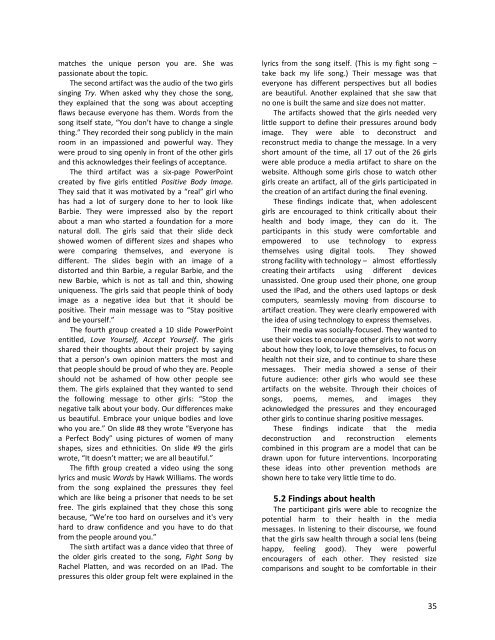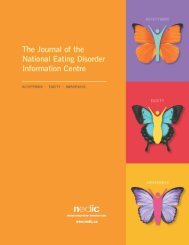NEDIC Conference Journal 2018
Create successful ePaper yourself
Turn your PDF publications into a flip-book with our unique Google optimized e-Paper software.
matches the unique person you are. She was<br />
passionate about the topic.<br />
The second artifact was the audio of the two girls<br />
singing Try. When asked why they chose the song,<br />
they explained that the song was about accepting<br />
flaws because everyone has them. Words from the<br />
song itself state, “You don’t have to change a single<br />
thing.” They recorded their song publicly in the main<br />
room in an impassioned and powerful way. They<br />
were proud to sing openly in front of the other girls<br />
and this acknowledges their feelings of acceptance.<br />
The third artifact was a six-page PowerPoint<br />
created by five girls entitled Positive Body Image.<br />
They said that it was motivated by a “real” girl who<br />
has had a lot of surgery done to her to look like<br />
Barbie. They were impressed also by the report<br />
about a man who started a foundation for a more<br />
natural doll. The girls said that their slide deck<br />
showed women of different sizes and shapes who<br />
were comparing themselves, and everyone is<br />
different. The slides begin with an image of a<br />
distorted and thin Barbie, a regular Barbie, and the<br />
new Barbie, which is not as tall and thin, showing<br />
uniqueness. The girls said that people think of body<br />
image as a negative idea but that it should be<br />
positive. Their main message was to “Stay positive<br />
and be yourself.”<br />
The fourth group created a 10 slide PowerPoint<br />
entitled, Love Yourself, Accept Yourself. The girls<br />
shared their thoughts about their project by saying<br />
that a person’s own opinion matters the most and<br />
that people should be proud of who they are. People<br />
should not be ashamed of how other people see<br />
them. The girls explained that they wanted to send<br />
the following message to other girls: “Stop the<br />
negative talk about your body. Our differences make<br />
us beautiful. Embrace your unique bodies and love<br />
who you are.” On slide #8 they wrote “Everyone has<br />
a Perfect Body” using pictures of women of many<br />
shapes, sizes and ethnicities. On slide #9 the girls<br />
wrote, “It doesn’t matter; we are all beautiful.”<br />
The fifth group created a video using the song<br />
lyrics and music Words by Hawk Williams. The words<br />
from the song explained the pressures they feel<br />
which are like being a prisoner that needs to be set<br />
free. The girls explained that they chose this song<br />
because, “We’re too hard on ourselves and it's very<br />
hard to draw confidence and you have to do that<br />
from the people around you.”<br />
The sixth artifact was a dance video that three of<br />
the older girls created to the song, Fight Song by<br />
Rachel Platten, and was recorded on an IPad. The<br />
pressures this older group felt were explained in the<br />
lyrics from the song itself. (This is my fight song –<br />
take back my life song.) Their message was that<br />
everyone has different perspectives but all bodies<br />
are beautiful. Another explained that she saw that<br />
no one is built the same and size does not matter.<br />
The artifacts showed that the girls needed very<br />
little support to define their pressures around body<br />
image. They were able to deconstruct and<br />
reconstruct media to change the message. In a very<br />
short amount of the time, all 17 out of the 26 girls<br />
were able produce a media artifact to share on the<br />
website. Although some girls chose to watch other<br />
girls create an artifact, all of the girls participated in<br />
the creation of an artifact during the final evening.<br />
These findings indicate that, when adolescent<br />
girls are encouraged to think critically about their<br />
health and body image, they can do it. The<br />
participants in this study were comfortable and<br />
empowered to use technology to express<br />
themselves using digital tools. They showed<br />
strong facility with technology – almost effortlessly<br />
creating their artifacts using different devices<br />
unassisted. One group used their phone, one group<br />
used the IPad, and the others used laptops or desk<br />
computers, seamlessly moving from discourse to<br />
artifact creation. They were clearly empowered with<br />
the idea of using technology to express themselves.<br />
Their media was socially-focused. They wanted to<br />
use their voices to encourage other girls to not worry<br />
about how they look, to love themselves, to focus on<br />
health not their size, and to continue to share these<br />
messages. Their media showed a sense of their<br />
future audience: other girls who would see these<br />
artifacts on the website. Through their choices of<br />
songs, poems, memes, and images they<br />
acknowledged the pressures and they encouraged<br />
other girls to continue sharing positive messages.<br />
These findings indicate that the media<br />
deconstruction and reconstruction elements<br />
combined in this program are a model that can be<br />
drawn upon for future interventions. Incorporating<br />
these ideas into other prevention methods are<br />
shown here to take very little time to do.<br />
5.2 Findings about health<br />
The participant girls were able to recognize the<br />
potential harm to their health in the media<br />
messages. In listening to their discourse, we found<br />
that the girls saw health through a social lens (being<br />
happy, feeling good). They were powerful<br />
encouragers of each other. They resisted size<br />
comparisons and sought to be comfortable in their<br />
35




